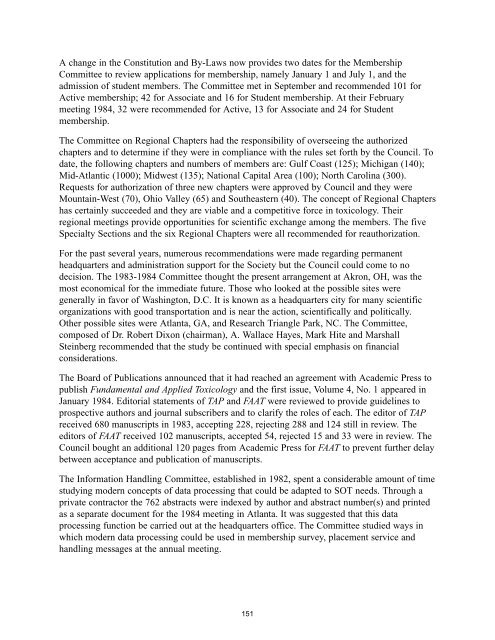SOCIETY O. TOXICOLOGY HISTORY - Society of Toxicology
SOCIETY O. TOXICOLOGY HISTORY - Society of Toxicology
SOCIETY O. TOXICOLOGY HISTORY - Society of Toxicology
Create successful ePaper yourself
Turn your PDF publications into a flip-book with our unique Google optimized e-Paper software.
A change in the Constitution and By-Laws now provides two dates for the Membership<br />
Committee to review applications for membership, namely January 1 and July 1, and the<br />
admission <strong>of</strong> student members. The Committee met in September and recommended 101 for<br />
Active membership; 42 for Associate and 16 for Student membership. At their February<br />
meeting 1984, 32 were recommended for Active, 13 for Associate and 24 for Student<br />
membership.<br />
The Committee on Regional Chapters had the responsibility <strong>of</strong> overseeing the authorized<br />
chapters and to determine if they were in compliance with the rules set forth by the Council. To<br />
date, the following chapters and numbers <strong>of</strong> members are: Gulf Coast (125); Michigan (140);<br />
Mid-Atlantic (1000); Midwest (135); National Capital Area (100); North Carolina (300).<br />
Requests for authorization <strong>of</strong> three new chapters were approved by Council and they were<br />
Mountain-West (70), Ohio Valley (65) and Southeastern (40). The concept <strong>of</strong> Regional Chapters<br />
has certainly succeeded and they are viable and a competitive force in toxicology. Their<br />
regional meetings provide opportunities for scientific exchange among the members. The five<br />
Specialty Sections and the six Regional Chapters were all recommended for reauthorization.<br />
For the past several years, numerous recommendations were made regarding permanent<br />
headquarters and administration support for the <strong>Society</strong> but the Council could come to no<br />
decision. The 1983-1984 Committee thought the present arrangement at Akron, OH, was the<br />
most economical for the immediate future. Those who looked at the possible sites were<br />
generally in favor <strong>of</strong> Washington, D.C. It is known as a headquarters city for many scientific<br />
organizations with good transportation and is near the action, scientifically and politically.<br />
Other possible sites were Atlanta, GA, and Research Triangle Park, NC. The Committee,<br />
composed <strong>of</strong> Dr. Robert Dixon (chairman), A. Wallace Hayes, Mark Hite and Marshall<br />
Steinberg recommended that the study be continued with special emphasis on financial<br />
considerations.<br />
The Board <strong>of</strong> Publications announced that it had reached an agreement with Academic Press to<br />
publish Fundamental and Applied <strong>Toxicology</strong> and the first issue, Volume 4, No. 1 appeared in<br />
January 1984. Editorial statements <strong>of</strong> TAP and FAAT were reviewed to provide guidelines to<br />
prospective authors and journal subscribers and to clarify the roles <strong>of</strong> each. The editor <strong>of</strong> TAP<br />
received 680 manuscripts in 1983, accepting 228, rejecting 288 and 124 still in review. The<br />
editors <strong>of</strong> FAAT received 102 manuscripts, accepted 54, rejected 15 and 33 were in review. The<br />
Council bought an additional 120 pages from Academic Press for FAAT to prevent further delay<br />
between acceptance and publication <strong>of</strong> manuscripts.<br />
The Information Handling Committee, established in 1982, spent a considerable amount <strong>of</strong> time<br />
studying modern concepts <strong>of</strong> data processing that could be adapted to SOT needs. Through a<br />
private contractor the 762 abstracts were indexed by author and abstract number(s) and printed<br />
as a separate document for the 1984 meeting in Atlanta. It was suggested that this data<br />
processing function be carried out at the headquarters <strong>of</strong>fice. The Committee studied ways in<br />
which modern data processing could be used in membership survey, placement service and<br />
handling messages at the annual meeting.<br />
151
















